Through Africa’s Gateway into the World’s Largest Goldfields
FAMOUS TRAINS - 1
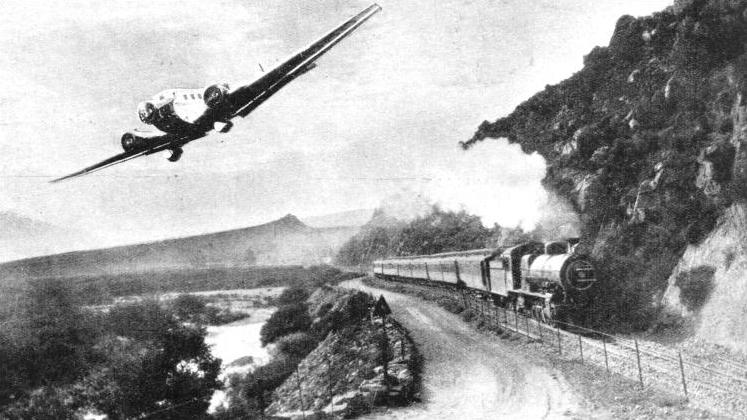
MODERN TRANSPORT is exemplified by the striking picture above. It shows the famous South African express, the “Union Limited”, passing along the banks of the Hex river, side by side with a mail-plane. This air service is operated by the railway company.
WHEN Francis Drake, on his famous voyage round the world, passed the Cape of Good Hope, he noted its beauty in the log of the Golden Hind - “the fairest Cape we saw in the whole circumference of the earth.” In later years many of the ships on the trade route to the East anchored at the Cape, but until 1652, when the Dutch East India Company established a base in Table Bay for re-victualling its vessels, none of these ships remained for any length of time.
The governor of this first settlement was Jan van Riebeeck, and his ship was appropriately called Goede Hoop. To-day this old sailing vessel, carved in stone, can be seen on a wall of the Castle at Cape Town, the first building erected by Europeans in South Africa.
Time, and the circumstance of Cape Town’s commanding position, led the insignificant settlement into its present-day role as the gateway to a vast and wealthy interior. Livingstone passed through Cape Town on his missionary journeys, and after him came Cecil Rhodes, with his dreams of a great future civilization for South Africa.
But without adequate transport no dreams of great nations can be realized. The railway was born in South Africa in 1859, when the construction of a line from Cape Town to Wellington was begun. From the following year till to-day the metals have slowly crept across the veldt, through valleys and over rivers, until now there are nearly 14,000 miles of track.
From Cape Town lines radiate in all landward directions, but the most interesting is the main-line route to Johannesburg, 956 miles to the northeast. Johannesburg is the centre of the gold-mining industry. At the end of the last century it was little more than a mining camp, but to-day it is one of the most important cities on the African continent.
Lord Milner visualized that the time would come when a million white people would call Johannesburg their town. And this bold conception has been made possible because of the railway, which gives “Jo’burg” rapid communication with the great ports of Cape Town and Durban.
One of the most modern and luxurious express services in the British Empire operates between Cape Town and Johannesburg. The well-known “Union Limited” covers the journey of 956 miles from the port to the inland mining centre in 30 hours and the return in 28½ hours. This train is composed of articulated first-class saloons, a magnificently furnished restaurant car, with a seating capacity of 46, and an observation coach attached at the back to afford the traveller an unobstructed view of the countryside.
Each compartment and coupe of the articulated coaches is equipped with a wash-basin supplied with hot and cold water, drinking water - a welcome amenity in the summer - and also steam-heating for the winter. The coaches are electrically lit, the current being drawn from two dynamos driven by the axles. In these saloons, and in the other modern coaches, the recessed reading lamps, serving both the upper and lower bunks, permit of easy reading at night. Corridors run along one side of the coaches, with a cross-over arranged at the centre, where a passage is provided by means of a vestibule gangway, similar to that establishing communication between the coaches themselves.
The train has hot and cold shower-baths, and an attendant is stationed in each carriage, both day and night. The train staff undertakes shoe-cleaning and a general valet service, and the deluxe expresses have fully qualified chefs to maintain the high standard of catering demanded.
The carriages in which the observation cars are included have lengths of 60 ft or over. One portion of the coach has accommodation for fourteen passengers, in three compartments and one coupe, while the observation car seats thirteen people.
The twin dining-car consists of two vehicles - one, the dining-saloon proper, the other, the kitchen and staff car - each vehicle being 60 ft in length. The saloon seats forty-six passengers, the whole of this section, with the exception of a small portion partitioned at one end as a bar, being set apart for meals.
The second vehicle contains not only the pantry and kitchen, but it also has accommodation for the catering staff. In the kitchen there is every facility for storing the food and drink required for the journey. All the latest hygienic devices are used, and the fittings in this section are made of stainless steel. The shelves are detachable so that they can be removed for sterilization. Larders and store cupboards are ice-cooled, with isolated compartments for fish and meat. Aluminium vessels are used for the cooking of all the food.
The journey of the “Union Limited” is necessarily a long one, as stated, and neither detail nor expense is spared to make that time one of complete comfort to the passenger.
The type of engine used in hauling the Cape Town-Johannesburg expresses is the 16 D.A. class, of the “Pacific” (4-6-2) type, with a leading bogie, six-coupled driving wheels, and a pair of wheels beneath the cab. The height of the boiler centre is 8 ft 6-in above the rails. The overall length of the engine and tender is 68 ft 9½-in, and the weight of the engine in working order is 90 tons 1 cwt. The total heating surface of the boiler is 2,573 sq ft. The tractive power of the locomotive at 75 per cent of the boiler pressure is 33,530 lb.
Another large South African locomotive used for hauling passenger trains over long distances is the 15 C.A. class, which has four leading, eight coupled and two trailing wheels (4-8-2 type). The length of this engine with tender is 73 ft 9-in, and it has a weight of 104 tons 13 cwt when in working order. The tender’s fuel capacity is 12 tons and the water capacity 6,000 gallons.
Cape Town Station, the starting point of the “Union Limited’s” route, not only deals with long-distance traffic, but is also the terminus of an extensive suburban system. The station possesses a large area of sidings and extensive depots for goods and coal storage.
Electric signalling has now been introduced at Cape Town. A few years ago automatic signals had been installed to ensure the safety of trains on only the long sections of the line and to protect trains in tunnels. Now the speeding-up of the train service, as a result of the suburban electrification, has made it necessary to erect more automatic signals, thus permitting a two-minute headway between trains. Colour-lights have also been adopted at Cape Town in place of the standard semaphore signals, and have demonstrated their greater efficiency both by day and night.
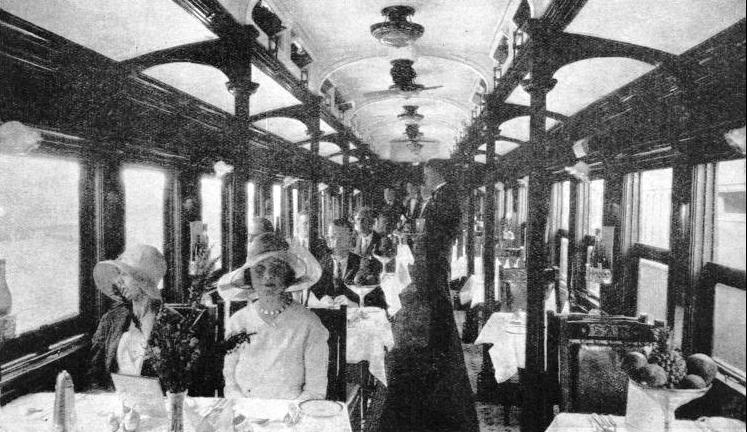
WELL-APPOINTED, this dining-saloon, which includes a small bar, can seat forty-six passengers. It is 60 ft in length, and forms the first half of the twin dining-car used on South African main line trains. The other half serves as a kitchen and staff car.
Another improvement has been the introduction of power signalling. One power-signal cabin at Cape Town now replaces two mechanical cabins and enables the signalling operations to be carried out more expeditiously.
Before the traveller boards the “Union Limited” at Cape Town for the journey to Johannesburg he will have seen something of South Africa’s mother city. He will have seen the world-famous Table Mountain on which clouds descend and unfold like a giant table-cloth; he will have seen the bustling harbour, the fine modern buildings along Adderley Street, and the castle.
As the “Union Limited” draws away from Cape Town the mighty mass of Table Mountain begins to fade into the distance, and the waters of Table Bay, gleaming in the sunshine, are shut out from view by the intervening hills.
The train next speeds into the “Wine Country”, where, in the late seventeenth century, some two hundred Huguenots settled, after they had been driven from France through the passing of the Edict of Nantes. The long, warm valleys of Paarl and Wellington were suited to what had possibly been their former trade - the culture of the vine. This region to-day is the greatest deciduous fruit-producing area in southern Africa, and supports an extensive wine and brandy industry, together with numerous jam-making and fruit-drying factories.
Lofty mountain ranges stand as Nature’s guardians to well-foliaged trees and meadows in these valleys.
As the “Union Limited” draws nearer to these mountains the bulk of the Matrooseberg looms overhead, and the train begins its long climb to the top of the Hex River Pass. At a first glimpse it seems to the traveller in the observation car, as the train rounds the sharp curves, that there can be no way up to the Pass. But then the express begins to wind along the contours of the foot-hills, all the while overcoming an average gradient of 1 in 40, and thus gradually approaching the summit.
Only the South African narrow-gauge track of 3 ft 6-in makes possible the use of such sharp curvature round these rugged contours. When the earliest railway engineers started out from Cape Town in 1859 they laid tracks set to the European gauge, 4 ft 8½-in. Later, however, it became apparent that to mount economically the passes to the highest interior plateau (4,000 to 6,000 ft above sea level) the curves and gradients must be altered to meet the special requirements of the country.
The narrow gauge affords an easier negotiation of curves and obviates wide embankments. The latest main-line track is laid with 96-lb flat-bottomed rails. These rails are put down in 40-ft lengths.
The wear of the rails under heavy traffic on sharp curves has been thoroughly investigated. On some of the 300-ft curves in Natal the life of an 80-lb rail on the outside of the curve lasted no longer than three months. Better results have been obtained by check-railing these curves and by using harder types of sorbitic and alloy steels. The life of the rails on the sharp curves that are adequately check-railed has been extended to about three years. (Check-rails are those placed inside a curve to prevent derailment.)
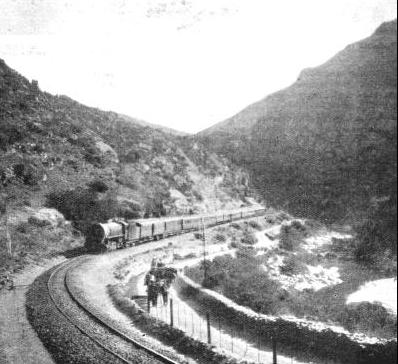
WINDING THROUGH VALLEYS, the trains have to overcome an average gradient of 1 in 40. This photograph of the “Union Limited” in the Tulbagh Kloof shows a difficult section of the line.
The sleepers (7 ft by 10-in by 5-in on main lines) consist chiefly of d’Jatti wood imported from Java, and Jarrah, imported from Western Australia. These have been found to be the most economical, and last from sixteen to twenty years. Small quantities of the indigenous hard timber of South Africa, chiefly yellowwood, obtained from the forests of the coastal belt, are also used. Reinforced concrete has been tried on a small scale in several designs for sleepers, but not with any great success.
While the “Union Limited” continues to climb the Hex River Pass, vineyards and orchards, interwoven with silver threads of rivers and snake-like rail-tracks, unfold in a wonderful panorama. The patterns of fairylike landscapes change as the train winds among the curves, until at last they vanish, and the travellers are left marvelling at the engineering skill which has enabled the express to reach the summit of the Pass.
The mountains have now disappeared and their place has been taken by an apparently endless plain stretching away in the distance to the far horizon - at first sight stark, silent, empty, and barren. Later, however, white dots, at first mistaken for rocks, prove to be sheep.
There are hundreds of thousands of these animals. The plain is a rich pasture-land. The train is now passing over a portion of the Great Karroo, a region of moderate rainfall, where nearly thirty millions of South African sheep, as well as a fair amount of game, feed on the hundred thousand square miles of land,
This district has an air of mystery and romance and contains some of the most beautiful scenery in the world. Quite unexpectedly, a wonderful sunset effect spreads away before the train. The sky stretches out like a golden sea towards which the express is heading. In this sea are set tiny islands - clouds of pearl, grey, and red, inviting the passenger to their non-existent shores.
Then a smart, white-coated steward interrupts the beauty of this scene with a brisk: “Will you take dinner at 6.30 or 7 o’clock, sir?”
After dinner the passenger reads and smokes, and a little later an attendant makes up the beds for the night. The sleeping berths differ entirely from those on the English and Continental railways. In South Africa the passenger’s compartment is his home for the journey, and the beds are erected at night and removed in the morning.
Early the next day a steward brings tea, and while the passenger enjoys a shower-bath his boots and clothes are cleaned, brushed and set out by another attendant. Now the headgears of Kimberley’s mines have come into view. Kimberley possesses two particularly notable attractions, one above and one below the ground. It is possibly the sunniest town in the whole world, and for its size the richest in mineral wealth.
At Kimberley Cecil Rhodes laid the foundation of his huge fortune, and the foundation, too, of a section of the British Empire extending the length of Africa: a dream that, in his early life, dominated his whole existence and incited him to found, practically single handed, the Dominion perpetuating his name - Rhodesia.
The rise of Kimberley has been, to a large extent, responsible for the early development of South Africa. Although, when gold was discovered on the Witwatersrand, the “big business” ensuing at Johannesburg partly eclipsed the fame of Kimberley, that town has gone on steadily mining diamonds for many years past. The aggregate value of the output is over £260,000,000.
The methods of mining and the recovery of the precious stones from the “blue ground” in which they are embedded have changed considerably with the times. The old quarries have given place to pits similar to those seen in coal-fields.
The “blue ground”, too, instead of lying in open places for years, to be disintegrated by natural elements, is now at once put through the “pulsator”, a mechanical contrivance which handles nearly 70,000 tons of “ground” every week in order to extract some 10¼ lb weight of diamonds.
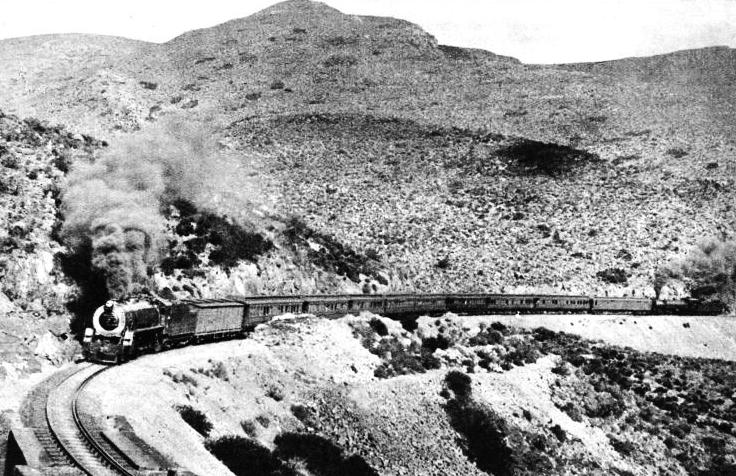
ACROSS THE MOUNTAINS. The railway overcomes the slopes of the mighty Matrooseberg (over 7,000 ft above sea-level), by means of the Hex River Pass. The pass is near Worcester, 135½ miles from the Cape.
At Kimberley passengers in the Durban section of the train have their coaches diverted. Just outside the town itself the railway track is divided, one line going due north to Rhodesia, the other - which the “Union Limited” follows - going north-east to the Transvaal.
The countryside changes little, apart from the fact that the open grass-lands give place to bush intersected with pastures and maize fields that glide past as the traveller watches from the observation coach. Not long after leaving Fourteen Streams, where the railway divides, the train reaches Bloemhof. This is the scene of the 1910 Gold Rush, and the few miles of derelict diggings, past which the express thunders, bear desolate witness of the vanquished hopes of the 10,000 diggers who sought their fortunes around this spot.
Some thirty miles on from Klerksdorp, the station after Bloemhof, the train speeds through Potchefstroom, the old Transvaal capital, dating back to 1839, four years after the beginning of the Great Trek from the Cape.
Some thousands of Dutch farmers, dissatisfied with the Government prevailing at the time, marched off to find new homes in the territory over which Moselkatze - Tchaka’s renegade general - and his bellicose impis ruled. How the Voortrekkers, as the farmers in the Great Trek were called, ultimately beat the savages in a battle at Blood River is a story by itself.
Approaching the Goldfields
And now another horizon swings into sight. Great white pyramids that might well be mounds of flour, smoke stacks and huge pit-headgears announce the beginning of Witwatersrand, the “white water ridge” which yields some forty million pounds’ worth of gold yearly - more than half the world's total output of the metal. One Johannesburg mine has already sunk a shaft 8,500 ft below the surface, or 2,500 below the level of the distant sea.
Less than fifty years ago Johannesburg was nothing more than a mining camp consisting of tents, covered wagons, and mud-walled huts with roofs of tarpaulin or reeds. As the “Union Limited” approaches it to-day the passenger, looking out of his compartment, sees a magnificent city of large buildings and a well-developed suburban area. To the visitor, Johannesburg’s greatest attraction is the mines. Permission can be obtained to view the surface workings and the Gold Refinery nine miles away at Germiston. In this refinery approximately 420 tons of standard gold and about 11 tons of silver are received every year. The mining machinery covers a vast range, amazing in its diversity, and still more amazing by the noise it creates. Each working day the mines bring up to the surface over 100,000 tons of rock, to be crushed to powder. In the whole process the considerable army of 25,000 white men and 200,000 natives are employed.
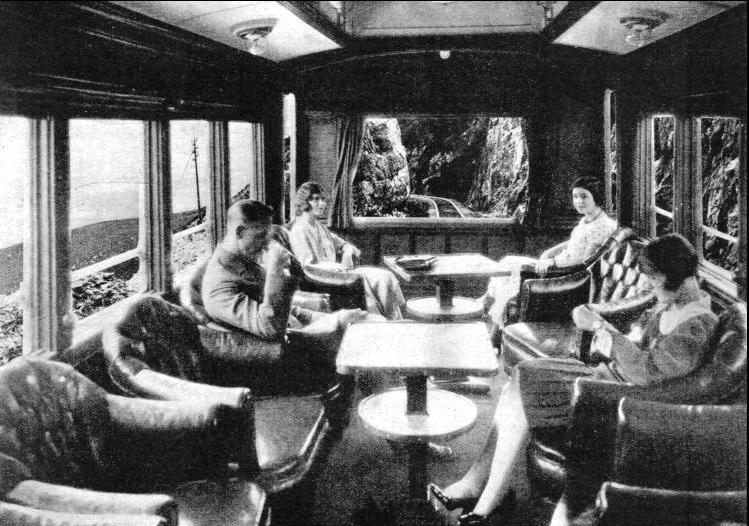
SUPERB VIEWS are to be seen from the observation coach on the “Union Limited”. This most popular section of the train resembles a miniature club-room, and its comfortable furnishing is here clearly revealed. There is seating accommodation for thirteen people.
On many South African trains the guards’ vans have accommodation for the conveyance of gold and diamonds. This comprises large safes, raised from the centre of the floor of the van so that a clear view on all sides is obtained by the guard.
Apart from its world-famed mines, Johannesburg has many other interesting aspects. As the largest and richest city in South Africa, its modernity comes as a striking contrast to the miles of veldt through which the “Union Limited” has passed.
The station at Johannesburg is of recent construction. It was completed in 1932 at a cost of nearly three-quarters of a million. This new building, in keeping with Johannesburg's importance in the Union, occupies an area of 486 ft by 208 ft. The structure consists of three storeys above level on one side and two storeys on the other frontages. A spacious hall, 164 ft by 124 ft, has been provided where the booking and other offices are situated.
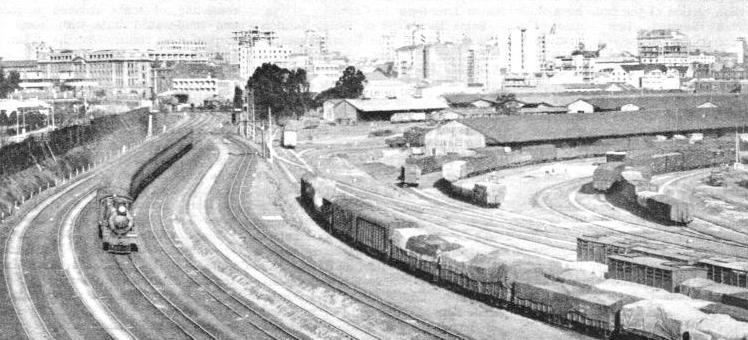
CITY OF GOLD - JOHANNESBURG. This great modern city is the centre of the world’s largest goldfields. Metal to the value of £1,200,000,000 has been extracted from the neighbouring mines. Johannesburg has a population of over 300,000, and lies 6,000 ft above sea-level. The railway journey from Johannesburg to the Cape by the “Union Limited” is supplemented by excellent services with other parts of South Africa.
The eight long platforms, which, for convenience, are subdivided and numbered 1 to 16, are easily reached through subways. Another feature of this station is the provision of overhead gantries, connecting the various platforms with the main building and the electric luggage lifts.
It is into this impressively modern station that the “Union Limited” finally brings the passenger, having covered the distance of 956 miles from the Cape in thirty hours. The Johannesburg depot for long-distance passenger trains and the yards for general goods and live stock traffic are at Braamfontein.
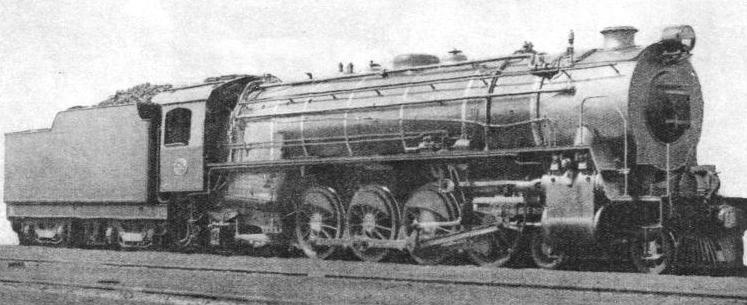
A SOUTH AFRICAN LOCOMOTIVE of the 15 C.A. class, type 4-8-2, used for passenger and goods traffic. The engine in working order weighs 104 tons 13 cwt, and has a length of 73 ft 9-in over the buffers. The boiler pressure is 200 lb per sq in, and the water capacity 6,000 gallons. The height of the boiler centre above the rails is 8 ft 6-in.
You can read more on “Developments in South Africa”, “Progress in Rhodesia”, “South African Electrification”, and “The Union Express” on this website.









